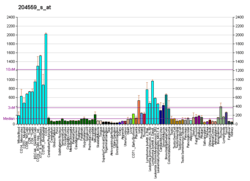LSM7
U6 snRNA-associated Sm-like protein LSm7 is a protein that in humans is encoded by the LSM7 gene.[3][4][5]
Function
Sm-like proteins were identified in a variety of organisms based on sequence homology with the Sm protein family (see SNRPD2; MIM 601061). Sm-like proteins contain the Sm sequence motif, which consists of 2 regions separated by a linker of variable length that folds as a loop. The Sm-like proteins are thought to form a stable heteromer present in tri-snRNP particles, which are important for pre-mRNA splicing.[supplied by OMIM][5]
Interactions
LSM7 has been shown to interact with TACC1[6][7] and LSM2.[8][9]
References
- ↑ "Human PubMed Reference:".
- ↑ "Mouse PubMed Reference:".
- ↑ Achsel T, Brahms H, Kastner B, Bachi A, Wilm M, Lührmann R (Oct 1999). "A doughnut-shaped heteromer of human Sm-like proteins binds to the 3'-end of U6 snRNA, thereby facilitating U4/U6 duplex formation in vitro". The EMBO Journal. 18 (20): 5789–802. PMC 1171645
 . PMID 10523320. doi:10.1093/emboj/18.20.5789.
. PMID 10523320. doi:10.1093/emboj/18.20.5789. - ↑ Ingelfinger D, Arndt-Jovin DJ, Lührmann R, Achsel T (Dec 2002). "The human LSm1-7 proteins colocalize with the mRNA-degrading enzymes Dcp1/2 and Xrnl in distinct cytoplasmic foci". RNA. 8 (12): 1489–501. PMC 1370355
 . PMID 12515382. doi:10.1017/S1355838202021726.
. PMID 12515382. doi:10.1017/S1355838202021726. - 1 2 "Entrez Gene: LSM7 LSM7 homolog, U6 small nuclear RNA associated (S. cerevisiae)".
- ↑ Conte N, Delaval B, Ginestier C, Ferrand A, Isnardon D, Larroque C, Prigent C, Séraphin B, Jacquemier J, Birnbaum D (Nov 2003). "TACC1-chTOG-Aurora A protein complex in breast cancer". Oncogene. 22 (50): 8102–16. PMID 14603251. doi:10.1038/sj.onc.1206972.
- ↑ Conte N, Charafe-Jauffret E, Delaval B, Adélaïde J, Ginestier C, Geneix J, Isnardon D, Jacquemier J, Birnbaum D (Aug 2002). "Carcinogenesis and translational controls: TACC1 is down-regulated in human cancers and associates with mRNA regulators". Oncogene. 21 (36): 5619–30. PMID 12165861. doi:10.1038/sj.onc.1205658.
- ↑ Lehner B, Sanderson CM (Jul 2004). "A protein interaction framework for human mRNA degradation". Genome Research. 14 (7): 1315–23. PMC 442147
 . PMID 15231747. doi:10.1101/gr.2122004.
. PMID 15231747. doi:10.1101/gr.2122004. - ↑ Lehner B, Semple JI, Brown SE, Counsell D, Campbell RD, Sanderson CM (Jan 2004). "Analysis of a high-throughput yeast two-hybrid system and its use to predict the function of intracellular proteins encoded within the human MHC class III region". Genomics. 83 (1): 153–67. PMID 14667819. doi:10.1016/S0888-7543(03)00235-0.
Further reading
- Friesen WJ, Dreyfuss G (Aug 2000). "Specific sequences of the Sm and Sm-like (Lsm) proteins mediate their interaction with the spinal muscular atrophy disease gene product (SMN)". The Journal of Biological Chemistry. 275 (34): 26370–5. PMID 10851237. doi:10.1074/jbc.M003299200.
- Suzuki H, Fukunishi Y, Kagawa I, Saito R, Oda H, Endo T, Kondo S, Bono H, Okazaki Y, Hayashizaki Y (Oct 2001). "Protein-protein interaction panel using mouse full-length cDNAs". Genome Research. 11 (10): 1758–65. PMC 311163
 . PMID 11591653. doi:10.1101/gr.180101.
. PMID 11591653. doi:10.1101/gr.180101. - Eystathioy T, Peebles CL, Hamel JC, Vaughn JH, Chan EK (Mar 2002). "Autoantibody to hLSm4 and the heptameric LSm complex in anti-Sm sera". Arthritis and Rheumatism. 46 (3): 726–34. PMID 11920408. doi:10.1002/art.10220.
- Conte N, Charafe-Jauffret E, Delaval B, Adélaïde J, Ginestier C, Geneix J, Isnardon D, Jacquemier J, Birnbaum D (Aug 2002). "Carcinogenesis and translational controls: TACC1 is down-regulated in human cancers and associates with mRNA regulators". Oncogene. 21 (36): 5619–30. PMID 12165861. doi:10.1038/sj.onc.1205658.
- Conte N, Delaval B, Ginestier C, Ferrand A, Isnardon D, Larroque C, Prigent C, Séraphin B, Jacquemier J, Birnbaum D (Nov 2003). "TACC1-chTOG-Aurora A protein complex in breast cancer". Oncogene. 22 (50): 8102–16. PMID 14603251. doi:10.1038/sj.onc.1206972.
- Lehner B, Semple JI, Brown SE, Counsell D, Campbell RD, Sanderson CM (Jan 2004). "Analysis of a high-throughput yeast two-hybrid system and its use to predict the function of intracellular proteins encoded within the human MHC class III region". Genomics. 83 (1): 153–67. PMID 14667819. doi:10.1016/S0888-7543(03)00235-0.
- Lehner B, Sanderson CM (Jul 2004). "A protein interaction framework for human mRNA degradation". Genome Research. 14 (7): 1315–23. PMC 442147
 . PMID 15231747. doi:10.1101/gr.2122004.
. PMID 15231747. doi:10.1101/gr.2122004. - Stanĕk D, Neugebauer KM (Sep 2004). "Detection of snRNP assembly intermediates in Cajal bodies by fluorescence resonance energy transfer". The Journal of Cell Biology. 166 (7): 1015–25. PMC 2172029
 . PMID 15452143. doi:10.1083/jcb.200405160.
. PMID 15452143. doi:10.1083/jcb.200405160.
This article is issued from
Wikipedia.
The text is licensed under Creative Commons - Attribution - Sharealike.
Additional terms may apply for the media files.
